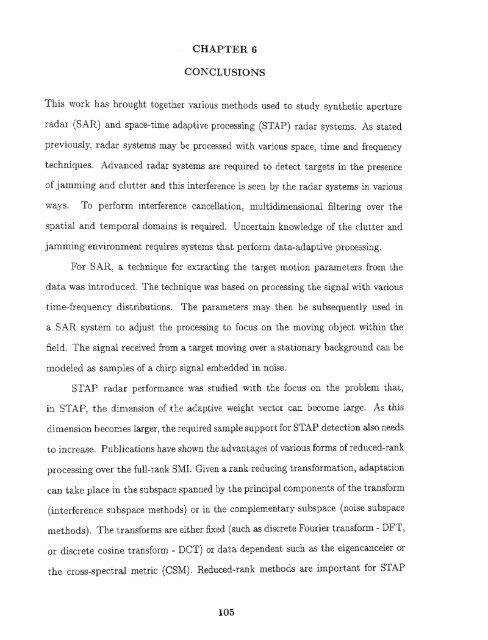Space/time/frequency methods in adaptive radar - New Jersey ...
Space/time/frequency methods in adaptive radar - New Jersey ...
Space/time/frequency methods in adaptive radar - New Jersey ...
You also want an ePaper? Increase the reach of your titles
YUMPU automatically turns print PDFs into web optimized ePapers that Google loves.
CHAPTER 6CONCLUSIONSThis work has brought together various <strong>methods</strong> used to study synthetic aperture<strong>radar</strong> (SAR) and space-<strong>time</strong> <strong>adaptive</strong> process<strong>in</strong>g (STAP) <strong>radar</strong> systems. As statedpreviously, <strong>radar</strong> systems may be processed with various space, <strong>time</strong> and <strong>frequency</strong>techniques. Advanced <strong>radar</strong> systems are required to detect targets <strong>in</strong> the presenceof jamm<strong>in</strong>g and clutter and this <strong>in</strong>terference is seen by the <strong>radar</strong> systems <strong>in</strong> variousways. To perform <strong>in</strong>terference cancellation, multidimensional filter<strong>in</strong>g over thespatial and temporal doma<strong>in</strong>s is required. Uncerta<strong>in</strong> knowledge of the clutter andjamm<strong>in</strong>g environment requires systems that perform data-<strong>adaptive</strong> process<strong>in</strong>g.For SAR, a technique for extract<strong>in</strong>g the target motion parameters from thedata was <strong>in</strong>troduced. The technique was based on process<strong>in</strong>g the signal with various<strong>time</strong>-<strong>frequency</strong> distributions. The parameters may then be subsequently used <strong>in</strong>a SAR system to adjust the process<strong>in</strong>g to focus on the mov<strong>in</strong>g object with<strong>in</strong> thefield. The signal received from a target mov<strong>in</strong>g over a stationary background can bemodeled as samples of a chirp signal embedded <strong>in</strong> noise.STAP <strong>radar</strong> performance was studied with the focus on the problem that,<strong>in</strong> STAP, the dimension of the <strong>adaptive</strong> weight vector can become large. As thisdimension becomes larger, the required sample support for STAP detection also needsto <strong>in</strong>crease. Publications have shown the advantages of various forms of reduced-rankprocess<strong>in</strong>g over the full-rank SMI. Given a rank reduc<strong>in</strong>g transformation, adaptationcan take place <strong>in</strong> the subspace spanned by the pr<strong>in</strong>cipal components of the transform(<strong>in</strong>terference subspace <strong>methods</strong>) or <strong>in</strong> the complementary subspace (noise subspace<strong>methods</strong>). The transforms are either fixed (such as discrete Fourier transform - DFT,or discrete cos<strong>in</strong>e transform - DCT) or data dependent such as the eigencanceler orthe cross-spectral metric (CSM). Reduced-rank <strong>methods</strong> are important for STAP105
















